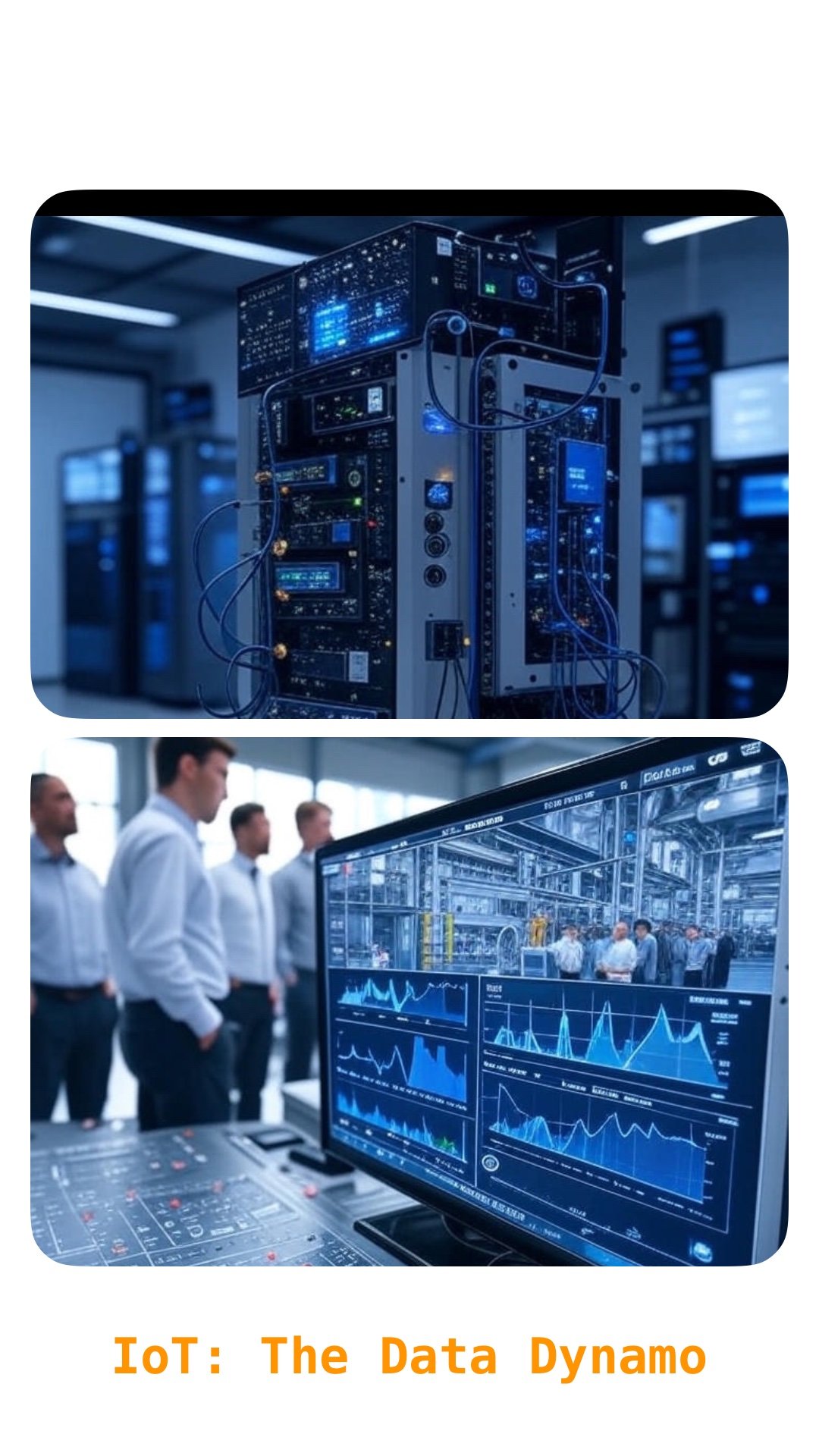The Convergence of IoT, Blockchain, Smart Contracts, and Generative AI: A New Era for B2B Innovation
The B2B landscape is evolving at breakneck speed, driven by the convergence of four technological powerhouses: the Internet of Things (IoT), blockchain, smart contracts, and generative AI. Each of these technologies is transformative in its own right—but their fusion is creating synergies that are redefining how businesses collaborate, innovate, and compete.
This convergence is not a passing trend; it is a strategic imperative for companies determined to thrive in a dynamic, hyperconnected global economy. Let’s unpack how these technologies are reshaping B2B projects and why now is the time to embrace their combined potential.
IoT: The Data Dynamo
The Internet of Things is revolutionizing B2B business models by enabling networks of interconnected devices that seamlessly exchange data and automate processes. From predictive maintenance in industrial machinery to real-time supply chain visibility, IoT is laying the groundwork for a more data-driven, efficient, and innovative business environment.
By harvesting vast streams of data from sensors and devices, B2B organizations can optimize operations, reduce downtime, and unlock new revenue streams. In short, IoT transforms data from a byproduct of operations into a core strategic asset.
Blockchain and Smart Contracts: The Trust Architects
Blockchain, with its decentralized ledger system, is fundamentally altering how B2B transactions are conducted. It offers a single, immutable version of the truth, dramatically reducing friction in partnerships and multi-stakeholder collaborations.
Enter smart contracts—self-executing agreements with the terms coded directly into the software. These digital contracts automate complex business processes, ensuring that all parties fulfill their obligations without the need for costly intermediaries. Trust, transparency, and efficiency are no longer aspirational goals—they are embedded in the very fabric of B2B transactions.
Generative AI: The Creative Catalyst
Generative AI represents the cutting edge of artificial intelligence, capable of producing original outputs—whether text, code, designs, or even entire products—based on the data it has been trained on. In B2B environments, generative AI is accelerating process automation, enhancing customer experiences, and revolutionizing product development cycles.
From rapidly generating software prototypes to automating customer support, generative AI empowers businesses to innovate faster, cut costs, and differentiate their offerings in increasingly competitive markets.
The Power of Convergence: Synergies in Action
When these technologies intersect, they don’t just add value—they multiply it. Here’s how their convergence supercharges B2B innovation:
➤ Enhanced Decision-Making
IoT delivers real-time data streams. Blockchain ensures the integrity and immutability of that data. Smart contracts automate decision workflows. Generative AI provides predictive insights and recommendations. Together, they enable data-driven decisions that are faster, more accurate, and more strategic.
➤ Streamlined Operations
Integrating IoT with blockchain and smart contracts enables automated, secure, and transparent workflows. This seamless execution reduces errors, minimizes delays, and drives significant operational efficiencies.
➤ Innovation in Product Development
Generative AI can harness data from IoT devices to inspire and refine product designs, while blockchain safeguards intellectual property and smart contracts manage product lifecycle agreements. The result? Faster, more secure innovation.
➤ Improved Customer Engagement
IoT facilitates personalized, real-time interactions. Blockchain fosters trust through transparent processes. Generative AI enables hyper-personalized content and solutions at scale. Together, they elevate the customer experience to new heights.
Real-World Applications: Where Convergence is Already Driving Value
The fusion of these technologies is not theoretical—it’s already happening across industries. Here are some compelling examples:
Smart Contracts in Real Estate: Automated property rental agreements execute seamlessly when conditions are met, eliminating the need for middlemen.
Decentralized IoT Networks: Companies like Helium and IoTeX are merging blockchain with IoT to create decentralized, secure device networks, ensuring trustless data communication.
Blockchain for Cybersecurity: Firms such as GuardTime employ blockchain to secure sensitive data and manage digital identities, enhancing cybersecurity in B2B environments.
Healthcare Supply Chains: Platforms like SimplyVital Health and MedRec are using blockchain and IoT to track pharmaceutical supply chains and manage patient records, improving transparency and patient care.
Financial Services Revolution: Companies like Abra and Barclays leverage blockchain and smart contracts to streamline secure transactions and automate complex financial agreements.
Measuring ROI: Proving the Value of Convergent Technologies
Adopting these technologies represents a significant investment. But how do you measure the return?
1. Define Clear Objectives
Is your goal to reduce operational costs, accelerate innovation, or improve customer satisfaction? Clarity here drives relevant metrics.
2. Track Key Metrics
For IoT: number of automated processes.
For blockchain/smart contracts: reduction in transaction times or disputes.
For generative AI: volume of content generated, or time saved in product development.
3. Assess Cost Savings
Automation reduces labor costs and downtime. Transparent processes mitigate risks and compliance costs.
4. Evaluate Time to Value
How quickly does the technology deliver tangible benefits? Early wins often pave the way for larger strategic transformations.
5. Quantify Quality Improvements
Better data accuracy, fewer transactional errors, and more reliable products.
6. Identify Competitive Advantages
Offering new, differentiated products or services made possible only by these technologies.
7. Pilot Projects
Test before scaling. Pilots help assess feasibility and practical value while mitigating risks.
8. Risk Management
Factor in security vulnerabilities, compliance challenges, and potential technical debt.
9. Revenue Generation
Identify both direct revenue streams and indirect gains such as improved market positioning.
10. Strategic Positioning
Beyond financial metrics, consider how these technologies position your firm as a market leader and innovator.
Design Thinking: The Secret Sauce for Success
While technology is critical, human-centric design is the compass that ensures success. Design thinking—an iterative, user-centered methodology—plays an indispensable role in B2B projects involving complex technology stacks.
➤ User Empathy
In B2B, customer needs are complex. Design thinking ensures solutions address real pain points, not just technical possibilities.
➤ Holistic Problem-Solving
B2B projects often tackle “wicked problems.” Design thinking fosters early collaboration and a systems-oriented approach to find innovative solutions.
➤ Innovation Catalyst
By focusing on the desired future state, design thinking encourages breakthrough ideas beyond incremental improvements.
➤ Process Optimization
B2B companies excel at optimizing the empathize and define phases, leading to tailored, precise solutions.
➤ Competitive Advantage
Customer-centric innovation translates directly into customer loyalty and organic growth—key drivers of competitive differentiation.
Why Design Thinking Matters in Integrated Technology Projects
User-Centricity: Ensures that solutions resonate with the needs of end users, driving adoption and satisfaction.
Collaboration: Cross-functional teams—from engineers to business strategists—collaborate effectively under the design thinking framework.
Innovation: Encourages experimentation and iterative development, vital in integrating cutting-edge technologies.
Risk Reduction: Early prototyping surfaces challenges before they become costly problems.
Adaptability: Keeps projects responsive to evolving markets and technological advancements.
In short, design thinking is not optional—it’s the strategic bedrock upon which successful B2B technology initiatives are built.
Conclusion: The Future of B2B is Convergent
The convergence of IoT, blockchain, smart contracts, and generative AI is reshaping the B2B arena. These technologies amplify each other’s strengths, offering companies unprecedented opportunities to streamline operations, innovate boldly, and engage customers in new ways.
Businesses that strategically embrace this convergence—armed with a design thinking mindset—will not only survive but lead in the next era of digital transformation.
The future is not just about adopting new technologies; it’s about integrating them thoughtfully to create sustainable, differentiated value. For forward-thinking B2B leaders, the convergence revolution is just beginning.
Ready to explore how these converging technologies can transform your B2B business? Let’s discuss your next project!






